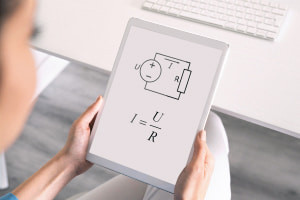Ohm's Law expresses the relationship between current, voltage and resistance in an electrical or electronic circuit. Knowing any two values, such as voltage and current, voltage and resistance, or current and resistance, will allow you to calculate the third value mathematically. Understanding the math behind these relationships can help you improve your diagnostic thought process and will enable you to narrow down electrical faults more quickly. Series circuits are helpful for when you want components to share the source voltage or when lower than the source or battery voltage is desired. Parallel circuits are used when we want each device to receive the full source voltage. Series parallel circuits are used when a combination of the series and parallel traits are needed. This course will focus on the first of the three types of circuits, the series circuit.
We will start the course by studying some keywords and terms to get you up to speed on the language and terminology of electrical circuits. We will then explore Ohm's Law in a graspable manner to allow for quick and easy progress through the Ohm's law practice example lessons. The course also focuses substantially on illustrating and explaining the series circuit rules. This will prepare you for the series circuit math calculations and exercises that follow. We will explain how to determine the order of the math calculations so that you won't have to do any further guesswork. Numerous practice examples are provided and reviewed. The course also offers a few recorded live demo lessons to demonstrate series circuits, using real components to help solidify your understanding. Understanding Ohm's law math is useful to help students discern incorrect voltage measurements and generally become better at electrical diagnostics and troubleshooting.
We have geared this course toward automotive students, beginner electronics students, and DIY-ers looking for a solid foundation in series circuits and Ohm's Law. We will walk you through the thought process, steps and reasoning behind them. Join me, Steve Liguori, in this course and start your journey toward a satisfying grasp of the three types of circuits used in basic automotive and electronics. Once you finish the series course, look for my parallel circuits and series-parallel circuits courses to complete your journey. Let's get started!
What You Will Learn In This Free Course
View All Learning Outcomes View Less All Alison courses are free to enrol, study, and complete. To successfully complete this Certificate course and become an Alison Graduate, you need to achieve 80% or higher in each course assessment.
Once you have completed this Certificate course, you have the option to acquire an official Certificate, which is a great way to share your achievement with the world.
Your Alison certificate is:
- Ideal for sharing with potential employers.
- Great for your CV, professional social media profiles, and job applications.
- An indication of your commitment to continuously learn, upskill, and achieve high results.
- An incentive for you to continue empowering yourself through lifelong learning.
Alison offers 2 types of Certificate for completed Certificate courses:
- Digital Certificate: a downloadable Certificate in PDF format immediately available to you when you complete your purchase.
- Physical Certificate: a physical version of your officially branded and security-marked Certificate
All Certificate are available to purchase through the Alison Shop. For more information on purchasing Alison Certificate, please visit our FAQs. If you decide not to purchase your Alison Certificate, you can still demonstrate your achievement by sharing your Learner Record or Learner Achievement Verification, both of which are accessible from your Account Settings.











 Avg. Hours
Avg. Hours  Contains Video
Contains Video  CPD Accredited
CPD Accredited 
 Total XP:
Total XP: 
 Knowledge & Skills You Will Learn
Knowledge & Skills You Will Learn 







